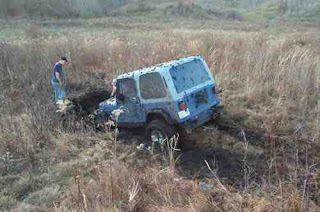
Truth be told, sewing up holds no magic for me, other than the fact that in some cases it's a time to breathe a sigh of relief. (A main attraction of neck surgery is that once the fun's over, closing happens in the blink of an eye.) Still, it's not a time to stop paying attention. As in all aspects of an operation, there are dangers, and there are ways to screw it up. On the other hand, keeping your eye on the ball doesn't preclude a little relaxation. With very little encouragement (most often, without any at all) I'm liable to launch into my repertoire of Gilbert and Sullivan or Rogers and Hammerstein. I can do most of the parts in "HMS Pinafore," and a truly show-stopping "
Pore Jud is Daid," keeping it up until the circulator, sighing with force that could break bricks, marches over and turns up the radio.
The anesthesiologist has a tough job: ideally, the abdominal muscles are fully relaxed (paralyzed) for closure, because it keeps the patient from pushing the guts into the wound, and it makes approximation of those muscles much easier. And yet it's also nice to see the patient fully able to breathe by the time the bandage goes on. Some are better at it than others; and surgeons make it harder by being unpredictable. Not me, of course. Today, it's one of the good ones; while I sew perfectly limp muscles, he tells me about his latest attempt to electrocute squirrels. Been reading about Ben Franklin, made a model of his capacitor or some damn thing.
Closing the peritoneum -- the freeing of which on the way in I described a couple of weeks ago (has it been that long?) -- helps. Not everyone does it. In addition to holding the insides in during the rest of the closure, it allows thorough irrigation of the incision with that nice brown solution I used in the belly. I place a couple of
large and tough clamps on the edge of the muscle (the
fascia -- the halves of the
linea alba I divided when making the initial incision), at about the mid-point of the incision. Joanie lifts them up and together with one hand, and with the other elevates a small retractor I've placed at the apex of the wound. That's hard work (although it's good for the pecs) so it helps to be fast. I run a whip-stitch down the peritoneum, and give her a break while I wash out the wound. It's at this point that I infiltrate, generously, with long-acting local anesthetic: the peritoneum, above and below the muscle on both sides, just below the skin.
Having been trained -- as were we all back then -- to close the muscle layer with interrupted (individual, one at a time) sutures, of non-dissolving material, it took overcoming many voices in my head to switch to a running suture made of stuff that goes away in a few months. But it's better in every way, starting with taking less time, passing through less pain, and ending with better healing. Studies confirm it. I strongly believe in taking large bites, well away from the edge and widely spaced. Choking off the wound with too many sutures, placed too closely, and pulled too tight means more pain and less healing. You couldn't break #1 vicryl if you tried; I use it on a big honkin' needle, grab it and the fascia with monster
Russian forceps, and it comes together as it should. When the bowel is distended or when there are other reasons why it's hard to keep things inside when closing, there are various tools you can slide under the muscle while the sutures are placed. What you don't want to do is forget to remove them before you finish:

The scrub and the circulator are pointing at piles of sponges and counting them together.
"Seven, eight, nine, ten.... seven, eight, nine...." They rustle around. The scrub reaches up and picks at the drapes near my belly.
"You missing a sponge? What kind? I know there's nothing inside... A four-by-eight? You got all the laps? The only four-by-eights were on the sponge sticks and I gave 'em all back to you..." I start looking around as well: under the table, lift up my shoes, peek under the drapes as far as I can without contaminating the field.
Shit. Am I going to have to re-open?
"Here it is! It was in a lap..." Most of the time, the counts are correct. When not, invariably the missing sponge or needle gets found somewhere outside of the patient. Twice, I think, I've actually had to reopen and have dug one out. Huge thanks to the nurses, abject embarrassment. Never have I left one in and taken the patient to the recovery room. I wouldn't like that.
My skin closure consists of a few fine interrupted sutures under the skin, followed by steri-strips. It's quick, cosmetically nice, and people can shower in a day or two. The only downside is the strips sometimes look a little bloody; but any disapproval of that is more than made up by the happy realization that there're no stitches to remove. Skin staples, plainly, suck. I put on the smallest bandage possible, believing that big ones are too scary.
I hang around to help move the patient onto the gurney; in fact, I usually go into the hall to get it, grab a roller on the way past where it's leaning against the wall, slide it onto the gurney while steering. Pump the gurney up to table height, roll the patient away, slide the roller under, then glide the patient onto the gurney, roll her the other way, remove the roller.
"Thanks, everybody. See you in a few minutes."When I have a line-up of cases, I head first to pre-op to talk to the next patient. Then to the family waiting area to talk about the just-finished case; then to the recovery room to have a look at my patient, write orders, dictate the op note. I always talk to the awakening patient, giving some good vibes, even though without exception, they never remember the conversation. If it's the A-team in the OR, by the time I'm done the next patient is ready to go into the room. The layout is such that I can see when the gurney is on the go. Usually, though, it's not that efficient. Stewing and brewing in the lounge while things happen too slowly for me... In this case, I have to run down to the ER to see what's going on with that acute abdomen they called about. I let the desk know I might have an add-on. And I guess I'll check to see if Carol ever got ahold of Dr. Smith...
I walk into the spacious surgery waiting room. Groups of families and friends have staked out their spots with pillows, books, blankets; couple of kids running around, TV on too loud. Heads turn expectantly, then look away, disappointed, when they see it's not their surgeon. I look for familiar faces, the volunteer at the desk helpfully nods toward the corner. Striding over, green-clad, I'm not unaware of the drama, the reading of my face as I approach. I give a smile and a thumbs-up before I'm in earshot.
"She's fine, she's in the recovery room, everything went great." Getting the important stuff out right away, watching the tension dissipate, people visibly relax.
"It was just as we expected, diverticulitis; everything went fine. I think she's gonna be really happy we did this. Did some of my best work... (Wait for the laugh.)
She'll be in recovery give or take an hour and a half. They usually don't let visitors in there, but they'll let you know when she's heading to her room. Anybody have any questions?..." We talk a while more and, yes, I have to say I drink in the gratitude, the relief, the optimism. The sense of accomplishment. If that weren't part of it, what would be the point?
As I get up to leave, something occurs to me:
"Oh, by the way, I realize I said it'd only take an hour or so, and it's been three weeks. Hope it didn't worry you....""It's OK doc," her husband says.
"Blogging's a bitch."





.jpg)

































